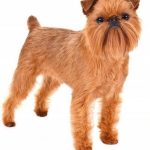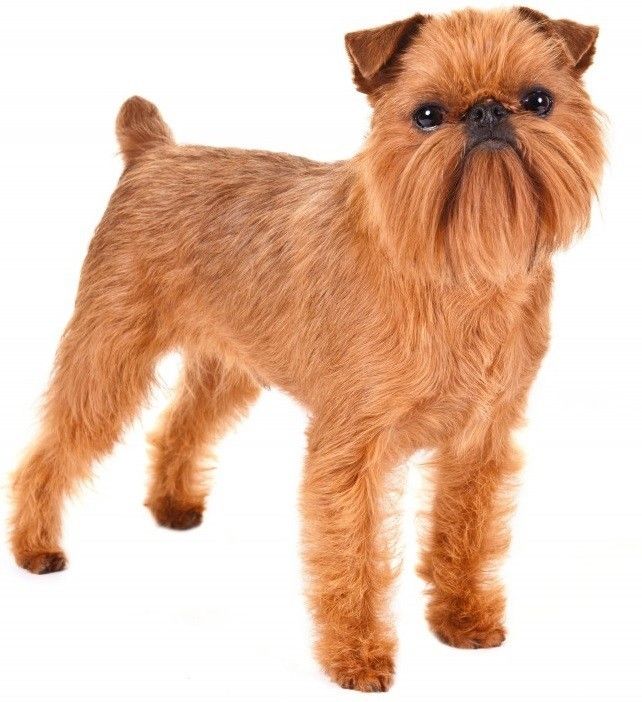As with many dog breeds, the most important part of coat care for a Brussels Griffon is brushing. After you’ve acclimated your dog to the grooming procedure, he will feel that standing on the table is no problem at all. At that point you can pick up the brush and run it through his hair.
If he doesn’t like it, do it just once, give him a treat, and put him on the floor. You want to move only by baby steps and build a little on each one he takes. Soon enough he’ll be a puppy who’s happy to get up on the table and be groomed. He’ll think that it’s easy and fun, and he’ll have confidence in you as his leader.
Let your Brussels Griffon sniff and examine the brush. Don’t correct him if he wants to bite or chew it; that’s his normal puppy response. You won’t be leaving it anywhere he can get hold of it. Then, stroke him gently on his back with the brush, and give him a treat—just one stroke, followed by a treat.
Staying still to receive a lot of strokes is a separate step. In your first few lessons, get him accustomed to letting you brush every part of his body. Talk to him in a normal voice. If he tries to get away or cries, do not comfort him. Comforting is a treat, and he will feel he was correct to cry or run.
How often should you brush your Griffon?
Once a week is a good, though he’d be happy if brushed every day. Check to make sure there is no hair in his eyes and, at the other end, no hair stuck to the rectum or urinary areas; in both places hair must be kept short, or else it will mat and collect dirt, which will cause the dog discomfort. Use small scissors with rounded tips to cut away any mats or long hair in those areas.
Weekly Grooming Routine
- Brush entire body with pin brush.
- Use a flea comb to check for fleas and ticks.
- Comb out leg furnishings and beard.
- Wipe around eyes with cotton swab.
- Trim hair around eyes.
- Trim hair around rectum or urinary areas.
- Swab ear canal.
- Clip tips of nails.
Combing, Trimming, and Clipping
After  your Brussels Griffon has learned to accept the brush on his body, teach him to accept the comb on his legs and beard. Next, teach him to accept scissors (used for trimming hair around the eyes) around his head, by gently rubbing a closed pair over his head and then across his cheek.
your Brussels Griffon has learned to accept the brush on his body, teach him to accept the comb on his legs and beard. Next, teach him to accept scissors (used for trimming hair around the eyes) around his head, by gently rubbing a closed pair over his head and then across his cheek.
The next lesson is to get your dog to relax while he is being clipped. Even if you plan on having him groomed by a professional, he will be much better off if he has learned not to mind the noise and feel of clippers, because groomers don’t always take the time to teach this to a puppy; they have to get on to the next dog.
If your Brussels Griffon won’t relax he might have to be held down during the clipping process, leaving him terrified. So let him inspect clippers while they are turned off. Graduate to running the turned-off clippers over all parts of his body, praising him when he stands still and relax.
Then, holding the clippers about 4 feet (1.22 m) away, turn them on. Speak normally to him to show him that the clippers are not scary. Turn them on and off. As soon as he relaxes and stands still, end the lesson. Take him off the grooming table.
At the next lesson, move the clippers closer or turn them on and off while you are sitting on the couch with him to teach him to accept the noise. Graduate to running the clipper body, not the blade, along his side. Don’t attempt to actually use the clippers until he is relaxed about this.
Ignore any bad reactions, and praise the calm ones and your Griffon will quickly get the message. With these lessons, you will eventually have a relaxed dog who enjoys his grooming and does not fight to get away, making it much easier for you to keep him looking snappy.
When you are finished with grooming or a lesson, take some time to play with your dog. Your attention is the reward he loves the most.
Grooming Tools You Will Need
- Pin brush
- Comb
- Flea comb
- Cotton swabs
- Scissors
- Clippers
- Nail clippers
- Table with nonslip surface

